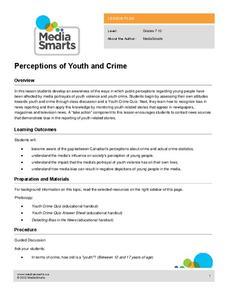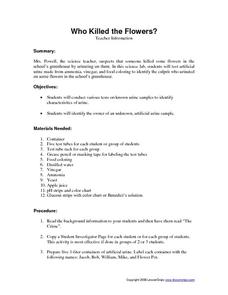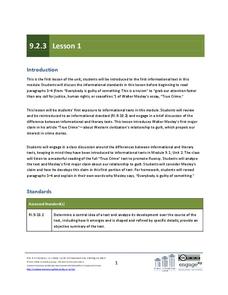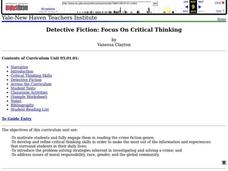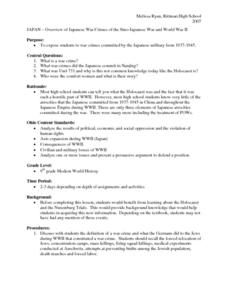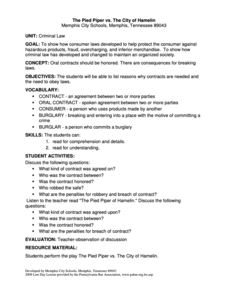Media Smarts
Perceptions of Youth and Crime
Explore the potential for bias in the news and in scholars' own attitudes and opinions. Begin with a quiz on youth crime to see how learners perceive crime among their peers. After looking at the correct answers, put individuals in...
Teaching Tolerance
Critiquing Hate Crimes Legislation
The high school lesson explores what hate crimes are and how the government has responded to those crimes. Academics read legislation, analyze political cartoons, and complete hands-on-activities to understand what motivates individuals...
Curated OER
Committing Crime or Just Having Fun?
Students breakdown different types of youth crime/gangs. Students evaluate the power of peer pressure. Students identify and offer advice for dealing with peer pressure. Students encounter the theory of phenomena.
Curated OER
Juvenile Crime in America: What Do We Value
Students investigate the statistical data provided in the Juvenile Offenders and Victims National Report. Students work in groups to create a story around a juvenile crime using the perspective of the juvenile offender, and another in...
Lesson Snips
Who Killed the Flowers?
This could be really good, or it could be really bad! The crime to be solved is, "Who went pee in the flowerpot?" Given four imitation urine samples, young chemists or crime scene investigators perform pH, glucose, and turbidity...
EngageNY
Grade 9 ELA Module 2, Unit 3, Lesson 1
"True-crime stories, murder mysteries, up-to-the-minute online news reports, and (as always) rumor and innuendo grab our attention faster than any call for justice, human rights, or ceasefires." Or so says Walter Mosley in his Newsweek...
Curated OER
The News Behind the Story
What a fun way to analyze plot, setting, and character. Learners review story elements, read a short fictional story, then turn the events of that story into a headlining news paper article. Not only does this lesson engage critical...
EngageNY
Grade 9 ELA Module 2, Unit 3, Lesson 9
Are we interested in crime stories because we either identify with the victims or enjoy watching the rich suffer? Do we feel guilty and want someone to take our blame and let us feel innocent? Groups investigate how the author of "How...
BBC
Crime
Crime and punishment! Learners discuss the law, civics, and crime in the UK. They brainstorm lists of crimes and possible punishments, complete activities on a website, role-play a Juvenile Court scenario, and try to think of ways they...
BBC
Crime: Justice
Are the juvenile courts fair? Learners read a bit from the classic Oliver Twist to consider how young people are treated and represented when they've been accused of a crime. They read a case study from their books, discuss children's...
Curated OER
Adjectives in Stories
In this adjectives worksheet, students match adjectives with descriptions of different types of stories. Students then read a news report and fill in the spaces with adjectives that begin with the specified letters.
Curated OER
Crime and Young People
Students read the story, "Police in Schools". They view a list of common offences committed by young people and identify the victims of these offences and consider how the offence would affect those people.
Curated OER
Planting Clues in Short Stories
Students examine short stories to determine how clues are planted in story stories of the mystery genre. They look at how Edgar Allan Poe planted clues in "The Purloined Letter." They write an original short story in which they plant...
EngageNY
Grade 9 ELA Module 2, Unit 3, Lesson 5
After rereading the full text of Walter Mosley's essay "True Crime," groups complete an evidence collection tool worksheet, and then class members independently draft a multi-paragraph, evidence-based response that identifies how Mosley...
Curated OER
Hanging the Sheriff, The Story of Henry Plummer
Students study who Henry Plummer was in relation to the history of Bannack, Montana. They examine his role as sheriff, what types of crime he dealt with and participate in a mock trial to determine if his hanging was justified.
Curated OER
Character's Motive: Sammy Keyes and the Hollywood Mummy
Sixth graders explore language arts by completing a reading comprehension worksheet. In this character study lesson plan, 6th graders read a crime story and investigate which character they belive committed the crime. Students complete a...
Curated OER
Detective Fiction: Focus On Critical Thinking
Turn your 6th graders into detectives while growing their love of reading. Using critical thinking skills, they will be able to describe the five basic elements of detective fiction, read detective novels, make predictions, use the...
EngageNY
Grade 9 ELA Module 2, Unit 3, Lesson 8
Class members continue reading "How Bernard Madoff Did It" and annotate how the author refines his idea that the Madoff scandal grabbed the attention of a public fascinated with crime stories.
Curated OER
Overview of Japanese War Crimes of the Sino-japanese War And World War Ii
Ninth graders discuss the definition of a war crime and what the Germans did to the Jews during WWII that constituted a war crime. The analyze the results of political, economic, and social oppression and the violation of human rights.
Curated OER
A Little Mystery and Intrigue in Writing Short Detective Stories
Learners read and analyze the twelve short stories in the novel "The Adventures of Sherlock Holmes." They create their own detective that has to solve a new kind of crime, and write and edit a short story with their original detective as...
Curated OER
Who Did It?
Students explore how forensic science is used in criminal investigations. They learn that for the next few days that are going to try to solve a crime that took place in the classroom. Students are given a story to read about the crime...
Curated OER
Classic Short Stories- Locked Room Settings
Young scholars read the short story "The Problem of Cell 13" and examine the plot devices that build suspense. In this lesson students create their own short story using the same locked room setting.
Curated OER
Night: Unsent Letters Writing Strategy
As part of their study of Elie Wiesel's Night, individuals assume the voice of an Auschwitz survivor and craft a letter to a former SS officer who worked at the camp and claims he is not guilty of any crime.
Pennsylvania Bar Association
The Pied Piper vs. The City of Hamelin
How would the Pied Piper recover his damages from the deceptive citizens of Hamelin if the story took place today? Explore one of the Pied Piper's options with a short play that depicts a court case in which he sues the city of Hamelin...


